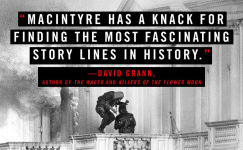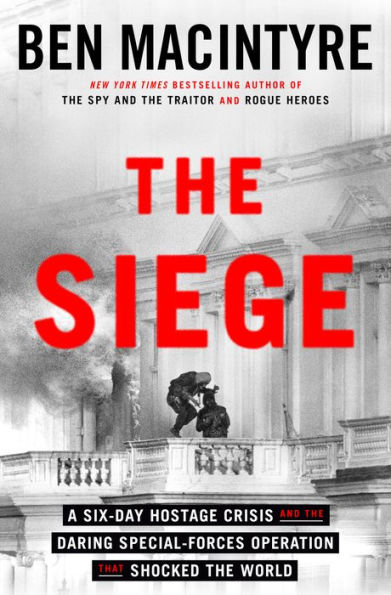The Siege: A Six-Day Hostage Crisis and the Daring Special-Forces Operation That Shocked the World
A thrilling tick-tock recounting one of the most harrowing hostage situations and daring rescue attempts of our time—from the true-life espionage master and New York Times bestselling author of Operation Mincemeat and The Spy and the Traitor.
“[Ben Macintyre is] John le Carré’s nonfiction counterpart.”—The New York Times
As the American hostage crisis in Iran boiled into its seventh month in the spring of 1980, six heavily armed gunman barged into the Iranian embassy in London, taking twenty-six hostages. What followed over the next six days was an increasingly tense standoff, one that threatened at any moment to spill into a bloodbath.
Policeman Trevor Lock was supposed to have gone to the theater that night. Instead, he found himself overpowered and whisked into the embassy. The terrorists never noticed the gun hidden in his jacket. The drama that ensued would force him to find reserves of courage he didn’t know he had. The gunmen themselves were hardly one-dimensional—all Arabs, some highly educated, who hoped to force Britain to take their side in their independence battle against Supreme Leader Ayatollah Khomeini. Behind the scenes lurked the brutal Iraqi dictator Saddam Hussein, who had bankrolled the whole affair as a salvo against Iran.
As police negotiators pressed the gunmen, rival protestors clashed violently outside the embassy, and as MI6 and the CIA scrambled for intelligence, Britain’s special forces strike team, the SAS, laid plans for a dangerous rescue mission. Inside, Lock and his fellow hostages used all the cunning they possessed to outwit and outflank their captors. Finally, on the sixth day, after the terrorists executed the embassy press attaché and dumped his body on the front doorstep, the SAS raid began, sparking a deadly high-stakes climax.
A story of ordinary men and women under immense pressure, The Siege takes readers minute-by-thrilling-minute through an event that would echo across the next two decades and provide a direct historical link to the tragedy on 9/11. Drawing on exclusive interviews and a wealth of never-before-seen files, Macintyre brilliantly reconstructs a week in which every day minted a new hero and every second spelled the potential for doom.
1144488308
“[Ben Macintyre is] John le Carré’s nonfiction counterpart.”—The New York Times
As the American hostage crisis in Iran boiled into its seventh month in the spring of 1980, six heavily armed gunman barged into the Iranian embassy in London, taking twenty-six hostages. What followed over the next six days was an increasingly tense standoff, one that threatened at any moment to spill into a bloodbath.
Policeman Trevor Lock was supposed to have gone to the theater that night. Instead, he found himself overpowered and whisked into the embassy. The terrorists never noticed the gun hidden in his jacket. The drama that ensued would force him to find reserves of courage he didn’t know he had. The gunmen themselves were hardly one-dimensional—all Arabs, some highly educated, who hoped to force Britain to take their side in their independence battle against Supreme Leader Ayatollah Khomeini. Behind the scenes lurked the brutal Iraqi dictator Saddam Hussein, who had bankrolled the whole affair as a salvo against Iran.
As police negotiators pressed the gunmen, rival protestors clashed violently outside the embassy, and as MI6 and the CIA scrambled for intelligence, Britain’s special forces strike team, the SAS, laid plans for a dangerous rescue mission. Inside, Lock and his fellow hostages used all the cunning they possessed to outwit and outflank their captors. Finally, on the sixth day, after the terrorists executed the embassy press attaché and dumped his body on the front doorstep, the SAS raid began, sparking a deadly high-stakes climax.
A story of ordinary men and women under immense pressure, The Siege takes readers minute-by-thrilling-minute through an event that would echo across the next two decades and provide a direct historical link to the tragedy on 9/11. Drawing on exclusive interviews and a wealth of never-before-seen files, Macintyre brilliantly reconstructs a week in which every day minted a new hero and every second spelled the potential for doom.
The Siege: A Six-Day Hostage Crisis and the Daring Special-Forces Operation That Shocked the World
A thrilling tick-tock recounting one of the most harrowing hostage situations and daring rescue attempts of our time—from the true-life espionage master and New York Times bestselling author of Operation Mincemeat and The Spy and the Traitor.
“[Ben Macintyre is] John le Carré’s nonfiction counterpart.”—The New York Times
As the American hostage crisis in Iran boiled into its seventh month in the spring of 1980, six heavily armed gunman barged into the Iranian embassy in London, taking twenty-six hostages. What followed over the next six days was an increasingly tense standoff, one that threatened at any moment to spill into a bloodbath.
Policeman Trevor Lock was supposed to have gone to the theater that night. Instead, he found himself overpowered and whisked into the embassy. The terrorists never noticed the gun hidden in his jacket. The drama that ensued would force him to find reserves of courage he didn’t know he had. The gunmen themselves were hardly one-dimensional—all Arabs, some highly educated, who hoped to force Britain to take their side in their independence battle against Supreme Leader Ayatollah Khomeini. Behind the scenes lurked the brutal Iraqi dictator Saddam Hussein, who had bankrolled the whole affair as a salvo against Iran.
As police negotiators pressed the gunmen, rival protestors clashed violently outside the embassy, and as MI6 and the CIA scrambled for intelligence, Britain’s special forces strike team, the SAS, laid plans for a dangerous rescue mission. Inside, Lock and his fellow hostages used all the cunning they possessed to outwit and outflank their captors. Finally, on the sixth day, after the terrorists executed the embassy press attaché and dumped his body on the front doorstep, the SAS raid began, sparking a deadly high-stakes climax.
A story of ordinary men and women under immense pressure, The Siege takes readers minute-by-thrilling-minute through an event that would echo across the next two decades and provide a direct historical link to the tragedy on 9/11. Drawing on exclusive interviews and a wealth of never-before-seen files, Macintyre brilliantly reconstructs a week in which every day minted a new hero and every second spelled the potential for doom.
“[Ben Macintyre is] John le Carré’s nonfiction counterpart.”—The New York Times
As the American hostage crisis in Iran boiled into its seventh month in the spring of 1980, six heavily armed gunman barged into the Iranian embassy in London, taking twenty-six hostages. What followed over the next six days was an increasingly tense standoff, one that threatened at any moment to spill into a bloodbath.
Policeman Trevor Lock was supposed to have gone to the theater that night. Instead, he found himself overpowered and whisked into the embassy. The terrorists never noticed the gun hidden in his jacket. The drama that ensued would force him to find reserves of courage he didn’t know he had. The gunmen themselves were hardly one-dimensional—all Arabs, some highly educated, who hoped to force Britain to take their side in their independence battle against Supreme Leader Ayatollah Khomeini. Behind the scenes lurked the brutal Iraqi dictator Saddam Hussein, who had bankrolled the whole affair as a salvo against Iran.
As police negotiators pressed the gunmen, rival protestors clashed violently outside the embassy, and as MI6 and the CIA scrambled for intelligence, Britain’s special forces strike team, the SAS, laid plans for a dangerous rescue mission. Inside, Lock and his fellow hostages used all the cunning they possessed to outwit and outflank their captors. Finally, on the sixth day, after the terrorists executed the embassy press attaché and dumped his body on the front doorstep, the SAS raid began, sparking a deadly high-stakes climax.
A story of ordinary men and women under immense pressure, The Siege takes readers minute-by-thrilling-minute through an event that would echo across the next two decades and provide a direct historical link to the tragedy on 9/11. Drawing on exclusive interviews and a wealth of never-before-seen files, Macintyre brilliantly reconstructs a week in which every day minted a new hero and every second spelled the potential for doom.
32.0
In Stock
5
1

The Siege: A Six-Day Hostage Crisis and the Daring Special-Forces Operation That Shocked the World
400
The Siege: A Six-Day Hostage Crisis and the Daring Special-Forces Operation That Shocked the World
400
32.0
In Stock

Product Details
| ISBN-13: | 9780593728093 |
|---|---|
| Publisher: | Crown Publishing Group |
| Publication date: | 09/10/2024 |
| Pages: | 400 |
| Sales rank: | 26,632 |
| Product dimensions: | 6.30(w) x 9.40(h) x 1.40(d) |
About the Author

From the B&N Reads Blog







